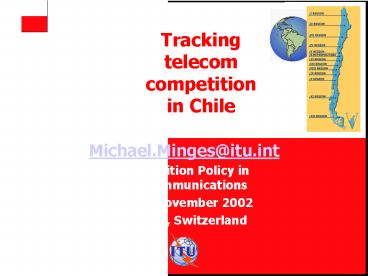Tracking telecom competition in Chile - PowerPoint PPT Presentation
Title:
Tracking telecom competition in Chile
Description:
... to the 'ends' of enhancing telecom access, it is nonetheless useful to measure. A high degree of competition would suggest that market is functioning properly ... – PowerPoint PPT presentation
Number of Views:47
Avg rating:3.0/5.0
Title: Tracking telecom competition in Chile
1
Tracking telecom competition in Chile
- Michael.Minges_at_itu.int
- Competition Policy in Telecommunications
- 20-22 November 2002
- Geneva, Switzerland
2
Measuring competition
- Although competition is a means to the ends
of enhancing telecom access, it is nonetheless
useful to measure - A high degree of competition would suggest that
market is functioning properly and therefore
prices should be lowest possible and access
enhanced
3
Telephone market 2001
Segment Operators Market size Incumbent market share a) HHI b)
Local 7 c) 3523700 lines in service 78 0.6
Domestic LD 12 2415 million minutes 38 0.3
International LD 12 241 outgoing362 incoming million minutes 38 0.3
Mobile cellular 4 5'271'565 subscribers 31 0.3
Note a) Based on market size indicator.
Telefónica CTC considered incumbent for local and
mobile, ENTEL for long distance (LD). b)
Hirfindahl-Hirschman Index. A measure of market
concentration. 1 monopoly, 0.2 or less
perfect competition. c) Not including rural
telephony concessions. Source ITU adapted from
CTC, SUBTEL data.
4
Local market
Incumbent share has dropped
but level of competition varies
- Of 11 local operators, four are rural only.
- Of 7 regular, three only operate in one region.
- Only incumbent operates nationwide in all 24
regions (primary zones). - Level of local competition
- Six regions have no local competition
- 10 have two operators
- 3 have three operators
- 2 have four operators
- 1 has five operators
- 2 have six operators
5
International long distance
Market concentration and price of 3 minute call
to US
- May 2002 33 operators licensed, 20 in operation
(SUBTEL, includes some double counting). 12
operators at end of 2001 (CTC). - Rapid drop in prices after introduction of full
competition on 27 August 1994. Market almost
reached perfect competition - Rise in market concentration after 1997 and
slight decline last two years. - Pricing seems to precede market changes. Market
correction in 1996 after competition settles in.
Since 1996 prices have been steadily declining. - Incumbent market share declined from 86 (92) to
38 (01).
6
Mobile
Mobile market share
- Numerous mergers and changes in regional
licensing complicate analysis. Six different
companies over 10 years. - Pricing seems to be relatively high compared to
other Latin American nations - Technologically diverse with two TDMA, one CDMA
and one GSM network
7
Competition impact
- What caused what in Chiles telecommunication
network development? - Difficult to disentangle impact of (1) economic
growth (2) privatization (3) regulation and
(4) competition. - Network growth a mixture of four pricing most
likely competition
8
Chile in the region
Annual average growth (1991-2001) Total telephone
subscribers (fixedmobile)
- Chile had fifth fastest growing telephone network
in Latin America during the 1990s - Outperformed peers (e.g., Brazil, Mexico,
Argentina) and regional average
9
Methodological considerations
- Need disaggregated data for competition analysis
- Operators claim because market competitive cannot
provide information. - Competitive market not straightforward
- Local concessions.
- Licenses for long distance when two services.
10
Conclusions
- Privatization and economic growth have driven
growth in local fixed market Impact of
competition has been negligible except perhaps in
spurring broadband. - Mobile market is no more competitive than most
other Latin American nations. - Biggest impact of competition has been on long
distance traffic.

